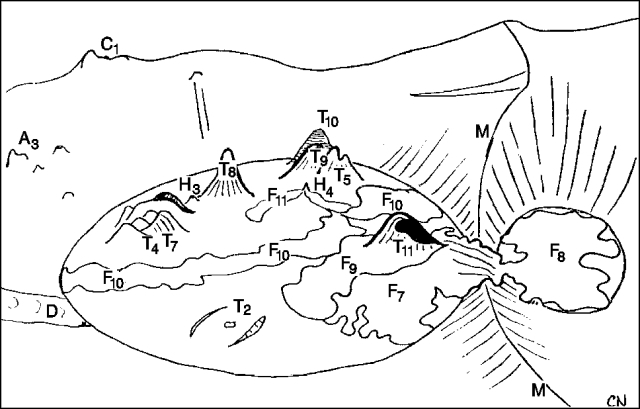Report on Ol Doinyo Lengai (Tanzania) — December 1988
Scientific Event Alert Network Bulletin, vol. 13, no. 12 (December 1988)
Managing Editor: Lindsay McClelland.
Ol Doinyo Lengai (Tanzania) Lava continues to flow onto main crater floor
Please cite this report as:
Global Volcanism Program, 1988. Report on Ol Doinyo Lengai (Tanzania) (McClelland, L., ed.). Scientific Event Alert Network Bulletin, 13:12. Smithsonian Institution. https://doi.org/10.5479/si.GVP.SEAN198812-222120
Ol Doinyo Lengai
Tanzania
2.764°S, 35.914°E; summit elev. 2962 m
All times are local (unless otherwise noted)
When geologists visited . . . 22-25 November, most of the crater floor had been covered by lava erupted since the end of June. A new 13-m-high cone (T11) was emitting aa lava onto the active crater floor (F7 and F9 in figure 11) and into the depression S of the saddle (F8) within an overflow channel 3 m deep and3/min and temperatures from [>582 -593°C]. A shimmer of heat and irregular gas blasts were observed from the E side of T4/T7, the site of lava lake activity and the source of small flows in June. T9 had grown and merged with T5, a site of minor activity in June. A number of fresh hornitos had formed W of T5, the largest being 1.5 m high (H4).
On 23 November at 0800, black lava continued to bubble within T11, but its flows had stopped and the overflow channel appeared blocked. During the night, a hornito (H4) W of T5 had emitted two pahoehoe flows that moved NW, one reaching the NW crater wall (F10 and F11, figure 11). Gas blasts continued from T4/T7, becoming more frequent that evening.
The next day at 0510, an eruption began W of T5, forming hornito H5 that was 1.5 m high and 1.1 m in diameter. At 0540, a new vent (T5B) opened on the SW slope of T5, emitting spatter and a thin fluid lava flow (F12) that extended a few tens of meters. Emission rates averaged ~0.1 m3/minute and temperatures ranged from [>579 to 593°C]. A gas-emitting pinnacle on the N side of T4/T7 spattered fresh lava, building a new cone. Another new cone that formed in the center of T11 ejected lava to 10 m. A small vent on the W side of T8 had ejected fresh spatter and glowed at depth.
On the 25th, [the inner] T11 cone was 2 m high. Lava bubbled gently within H5. Several new small pahoehoe flows had formed below T5B during the night and a flow continued in the morning. This lava encircled a fumarole near the base of the crater's E wall. Loud firecracker-like explosions were heard when lava flowed into the fumarole.
Further Reference. Dawson, J.B., Pinkerton, H., Norton, G.E., and Pyle, D.M., 1990, Physicochemical properties of alkali carbonatite lavas; data from the 1988 eruption of Oldoinyo Lengai, Tanzania: Geology, v. 18, p. 260-263.
Geological Summary. The symmetrical Ol Doinyo Lengai is the only volcano known to have erupted carbonatite tephras and lavas in historical time. The prominent stratovolcano, known to the Maasai as "The Mountain of God," rises abruptly above the broad plain south of Lake Natron in the Gregory Rift Valley. The cone-building stage ended about 15,000 years ago and was followed by periodic ejection of natrocarbonatitic and nephelinite tephra during the Holocene. Historical eruptions have consisted of smaller tephra ejections and emission of numerous natrocarbonatitic lava flows on the floor of the summit crater and occasionally down the upper flanks. The depth and morphology of the northern crater have changed dramatically during the course of historical eruptions, ranging from steep crater walls about 200 m deep in the mid-20th century to shallow platforms mostly filling the crater. Long-term lava effusion in the summit crater beginning in 1983 had by the turn of the century mostly filled the northern crater; by late 1998 lava had begun overflowing the crater rim.
Information Contacts: C. Nyamweru, Kenyatta Univ; J. Dawson, Univ of Edinburgh; H. Pinkerton and G. Norton, Univ of Lancaster; D. Pyle, Cambridge.


